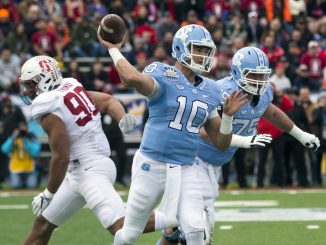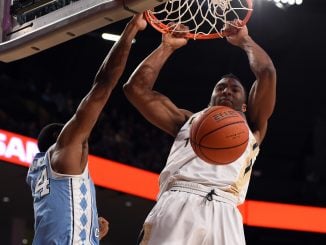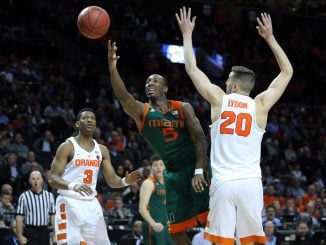
North Carolina had just beaten Pittsburgh by 20 points on the road, a win that combined with No. 1 Gonzaga’s loss later in the evening Saturday, prompting all the national talking heads to anoint the Tar Heels as the new favorite to win college basketball’s national title.
Coach Roy Williams’ veteran team, they said, was the most experienced, balanced and explosive in all the land.
So what did UNC do to solidify that claim?
It went to Virginia two days later and managed only 43 points against an opponent that came into the game having lost four of its previous five — including a 24-point humiliation to the very same Tar Heels in Chapel Hill.
When asked to make sense of the surprising result and the dramatic turnaround, Williams offered up an an explanation that was as simple and accurate as an uncontested layup.
“It’s the ACC,” he said. “This is a pretty doggone tough league.”
On that, there is no debate.
With less than a week remaining in the regular season, the ACC boasts nine teams in the top 50 of the RPI and 13 in the top 90, making it the highest-rated conference in the country. Its eight 20-win teams are three more than the league with the next highest total, the Big Ten.
Barring a rash of upsets in the so-called one-bid conferences or a bad loss to a double-digit seed in the opening round of postseason play next week in Brooklyn, the ACC stands a realistic chance of tying the old Big East’s record of 11 NCAA tournament bids set in 2011.
So where does that put it in historic perspective?
“I think this year it will go down as the best league in one single year in the history of college basketball,” Virginia Tech coach Buzz Williams said.
And he’s not alone in that thinking. Given the quality of depth in the league, especially in the middle and near the bottom of the standings, every game has the potential to be a struggle for survival.Louisville’s Rick Pitino, one of several current ACC coaches whose team was a member of the Big East in that record-setting 2011 season, said that the two leagues are comparable in their overall strength.
But unlike that Big East, which had bottom-feeders DePaul, South Florida, Providence and Rutgers against whom teams could take a deep breath and get an easy win, there are few if any soft touches in this year’s ACC.
Thirteenth-place NC State has a win against Duke at Cameron Indoor Stadium. Fourteenth place Pittsburgh beat Florida State by 14 points and Georgia Tech upset a UNC team that is already assured of at least a share of the regular season league title. Even cellar-dwelling Boston College, which has won only two conference games all year, has a victory against Syracuse — a team that is all but assured of an NCAA tournament bid.
“I think this is the most unique year of my 37 in the league as far as any team being able to beat the other,” Duke coach Mike Krzyzewski said. “Over the years, coaches say that because they don’t want to mention anything bad about anybody. But this year everybody means it. Literally any team can beat another team in our conference, and I’ve never seen that.
“It’s absolutely incredible. This is the most balanced the league has ever been from top to bottom.”
While that might be the case, proclaiming this year’s ACC as the best conference in college basketball history is difficult because there’s so many more teams squeezed in between that top and bottom now than there used to be in what is considered the league’s golden era.
That came between 1986 and 1991, a six-year span that saw the conference send six of its eight teams to the NCAA tournament four times while producing some of the greatest names ever to play the game. It’s a list that includes the likes of Len Bias, Johnny Dawkins, Mark Price, Jerry Stackhouse, Rasheed Wallace, Rodney Monroe and Chris Corchiani.
Most of those players stayed in school for three, and in some cases, four years, making the ACC a much more veteran league than it is today. But even with less experience and more quantity, Williams said that there’s still plenty of quality to go around.
“The depth of the league (in the old days) may not have been quite as good as it is right now,” he said. “That’s the biggest difference from seven teams to 15 teams. Of those 15 teams, 10 or 11 of them think they’re going to play in the NCAA tournament and should play in the NCAA tournament, because that’s the quality of the league.
“In the old days, we only played 12 league games, so it has changed drastically. The number of really good teams and the number of really good players far surpasses anything we’ve ever had.”
But how do you measure the strength of the two eras when the circumstances are so different?
If you go by percentage, ACC would fall short even if bubble teams Wake Forest and Georgia Tech both sneak into the field of 68. Eleven out of 15 teams is “only” 73.3 percent.
As far as ESPN analyst Jay Bilas is concerned, the most accurate measuring stick isn’t how many teams a conference gets into the tournament, but rather how those teams do once they get there.In that case, the standard this year’s ACC is chasing isn’t the 2011 Big East — which got only one other team besides eventual national champion UConn past the Sweet 16. It’s the 1985 version of that league, which produced three Final Four teams, including both that played for the title.
“Being a great league is confirmed by how you do in the [NCAA] Tournament,” said Bilas, whose perspective is unique, having played on a Final Four team himself, at Duke in 1986. “It will be hard for the ACC to match what it did last year in the tournament when it put six in the Sweet 16, four in the Elite Eight and two in the Final Four.
“I don’t know where all this ‘best conference ever’ got started. It’s certainly not the kind of league we saw in the ’80s and ’90s.”



